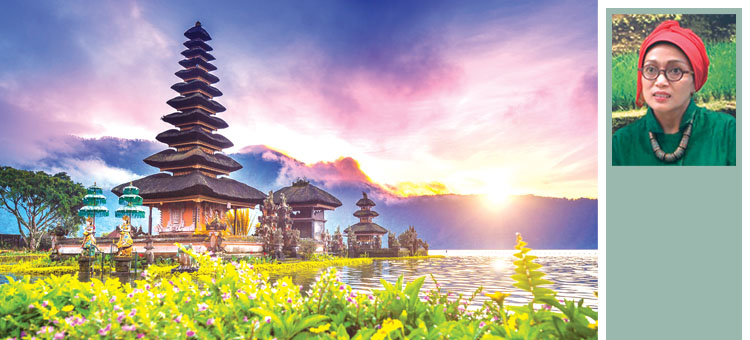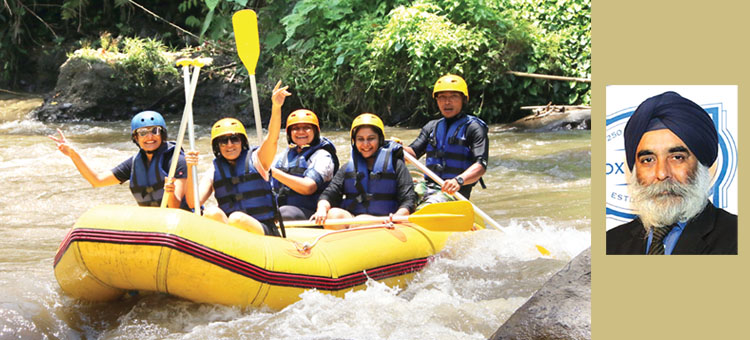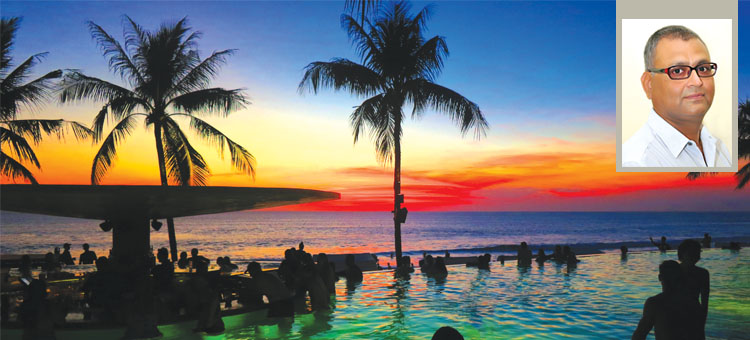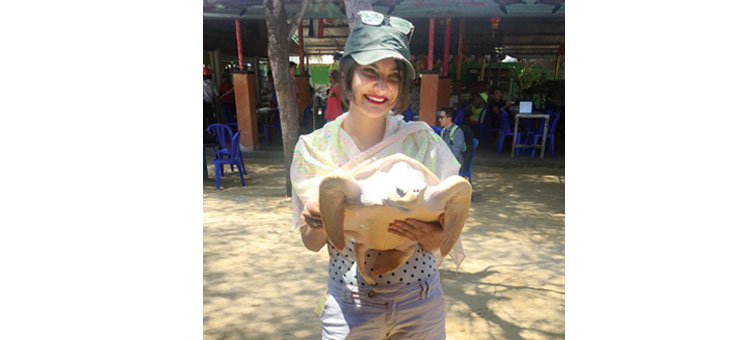Bali: Bali isn’t a far-off land you visit and then miss home. In fact, it’s a place you visit and find home. Meeting people who make you feel like family, one witnesses the kind of cultural expression that makes you realise we aren’t all that different. Bali is more than a destination. It’s a feeling, a state-of-mind.
In H1 2018, more than 3,40,000 Indians visited Indonesia as compared to the same period in 2017. “We are not satisfied by merely good organic growth, we need to challenge ourselves and raise the bar,” says Nia Niscaya, Deputy Minister, Tourism Marketing, Republic of Indonesia. “For 2018, the Ministry of Tourism, Republic of Indonesia (MoTRI), has set 7,00,000 visits as the target for the India market and that’s a huge 40 per cent increase from 2017.” MoTRI has signed up with MakeMyTrip for a major joint promotion.
Karan Anand, Head—Relationships, Cox & Kings Ltd., says according to Indonesia’s tourism ministry records, as many as 4,85,314 Indians travelled to Bali in 2017 which is a 30 per cent growth over 2016. “Honeymooners, leisure and luxury travellers from India prefer Bali for eye-catching scenery, incredible landscapes and beautiful temples. With multiple airlines flying between India and Indonesia through their various hubs, connectivity is excellent.”
Although Indonesia is made up of more than 17,000 islands, only one is truly world famous: Bali. The ‘Island of 1000 Temples’ or the ‘Island of the Gods’ clocked annual visitor intake of over 5 million in 2017. MoTRI states that India ranks third in the list of countries from where tourists visit Bali every year. Tracing the footsteps of author Elizabeth Gilbert, Bali has also been welcoming a deluge of young women travellers who want to enjoy the ‘Eat Pray Love’ experience.
“Our focus has been on tapping all potential segments of travel from India, while additional focus was laid on showcasing Indonesia as an ideal destination for weddings and golf,” says Sanjay Sondhi, Country Manager, VITO (Visit Indonesia Tourism Office) India. “In 2019, our main objective will be to showcase Bali and beyond. Though Bali itself has so much more to offer that one visit is just not enough.”
Tourism in Indonesia is one of the most important components of the country’s economy. Indonesia has planned to achieve 8 per cent GDP from the tourism sector and targets to attract about 20 million visitors by 2019. Singapore, Malaysia, China, Australia and Japan are the top five source markets for Indonesia.
Bali covers an area of 5,780 sq. km. The the population is estimated to be over 4.2 million. Home to the largest Hindu minority, over 83.5 per cent of the population follow Balinese Hinduism. According to the Jakarta Post, MoTRI is currently spending IDR 100 billion ($7.36 million) to promote Bali. Bali’s tourism industry has set the bar high for 2019, as it looks to attract 8 million foreign visitors. But to achieve this, the central government must support infrastructure initiatives across the island and not just the south which is where the Ngurah Rai International Airport is located. But this has created problems of congestion and garbage, exposing the limitations posed by carrying capacity of hotels. Currently more than 95 per cent of tourist arrivals to Bali go through Ngurah Rai, so alternative access points such as the construction of a new airport in the north and the optimization of the Benoa tourism port are positive steps.
Another issue of late is the lack of sensitivity shown by tourists. The administration is preparing a new regulation that will ban tourists from entering the main and most sacred parts of temples across the island after a series of incidents where boorish tourists desecrated holy sites, some even posing in the buff for selfies.
My maiden flight to Bali via Kuala Lumpur on AirAsia was uneventful. However we landed in Bali as the earthquake and tsunami ravaged Sulawesi, another island of Indonesia thousands of miles away from Bali, on September 28. But the news was enough to get folks back home worried.
We checked into Royal Casa Ganesha Hotel & Spa in Ubud. On day one we went white water rafting soon after breakfast. After gearing up with life jacket, helmet and paddle, we hopped on to the truck that would take us to the rafting point. We put our mobile phones in waterproof bags and I sat ahead to feel the rush of adrenalin. Along the way (two-hour rafting course) there were many points in the middle where teams could stop and eat some chips, down a can of beer or coconut water. Don’t worry about not carrying cash – the guide pays for everyone and we settle accounts with him at the end of the journey.
Next, was a 30-minute bus ride to the Sacred Monkey Forest, Ubud. Known as Mandala Suci Wenara Wana, it is the natural habitat of the Balinese long-tailed monkey. Located at Padangtegal Ubud, there are around 749 monkeys in this sanctuary. It’s funny how the monkeys just go about their business, eating corn. They have their own temple, Pura Dalem Agung (Great Temple of Death) where people are not allowed.
The Paon Bali Cooking Class was something I was eagerly looking forward to. It is the perfect way to embark on a culinary adventure that unlocks the secrets of authentic Balinese cooking using traditional methods and ingredients in a fully equipped community village kitchen. (3,50,000 Rp per person). The sessions are conducted in English by an expert Balinese chef. Authentic coconut oil is used to cook your choice of meat or vegetables. That the recipes and notes are takeaways is an added bonus. We used fresh herbs and spices, crisp vegetables and the choicest cuts of meats, under the guidance of our charming host Pushpa.
My favourite of the lot was the Sate Siap Sate Liit Ayam (minced chicken grilled on bamboo sticks); and the Tempe Me Goreng Temperance Kering (deep fried tempe in sweet soy sauce).
In Indonesia numerous Hindu temples stand testimony to their faith. Statues and sculptures depicting scenes from The Ramayana and The Mahabharata dominate the islands.
On day two we started early for the Ulun Danu Bratan temple on the shores of Lake Bratan in the mountains near Bedugul. In the early days this temple was used for conducting the offering ceremony for the Balinese Goddess of water, lakes and rivers, Dewi Danu, due to the significance of Lake Bratan as the main source of irrigation in central Bali. The locals wear a specific outfit when they pray – Safari for men and Kabaya for women. The temple closes at 5 pm for tourists but the prayers never stop. Today the land is filled with lush green grass and blooming with colourful flowers, surrounded by the water body where tourists can even take a boat ride (approx 200,000 Rp per person). This temple even has a playground for kids and a restaurant which serves Balinese food. Here I tried fried banana with palm sugar for the first time. Lipsmacking!
Penglipuran Village, the world’s third cleanest village with 1000 residents was next on the itinerary. The name Penglipuran is derived from the words that mean ‘remembering ancestral lands’. Penglipuran is located at the foot of Mount Batur at an altitude of 700 metres above sea level. The traditional houses are like those that date back 1,50,000 years. All the houses look similar. Soil is used for walls and bamboo for the roof. Tickets are available at 30,000 Rp and 25,000 Rp for adults and children respectively.
Though inhabited by the Balinese, the houses have become tourist attractions too. The locals welcomed us into their homes to explore. The setting is very basic: one bed and a cooking stove. Most of the men sleep outside as the house is small; women and children inside. There are toilets made of cement outside the houses. As family sizes grew, the huts have transformed to include walls. A board outside each house bears the names and number of family members.
The Balinese have a unique way of naming their children. Their first names reveal their chronological order in the family. The first name for a boy or girl is Wayan; Made (second); Nyoman (third); Ketut (fourth) and Wyan Balik (fifth born). Interesting and true.
The Tegallalang Rice Terrace is a lovely tourist spot with lush green fields and the famous Bali Swing. It costs 150,000 Rp for 15 swings for a single person and 300,000 Rp for the couple swing. They even have a zip line across the fields that costs 350,000 Rp per person. Cap, shades and sunscreen with SPF 50 are a must in Bali. The sun is so hot that we felt like a heat stroke would be unavoidable.
The Bali Swing is rightly called a playground for adults. Imagine swinging and gliding at various spots over lush green forests, rice fields, river valleys, awesome cliff views and much more. Get your cameras ready! Two of us tried the swing – scary at first but soon, with the wind in your face, it becomes enjoyable to the core.
The next day we arrived at the Secret Garden Village in Luwus Bedugul, an ‘eduvacation’ concept. Our first activity was the Oemah Herborist Beauty Soap Making Class where they taught us how to make ‘cupcake’ soaps (delicious looking soaps) and decorate it however we like. Honestly, I could almost take a bite! It definitely brought out my creative side!
The soaps take about an hour to cool down. So after we put our ‘cupcake’ soaps into the freezer, a tour of the factory followed. Our guide took us through the manufacturing process, explaining how the soaps are baked, tested and packaged to perfection. The aroma was so heavenly that I kept wishing it could be shared on social media! Well, maybe someday.
Lunch was at The Luwus, a Balinese-Asian Resto within the Secret Garden complex. We indulged in Balinese duck cooked in bamboo, better known as Bebek Timbungan, a ‘must try’ dish here. A hearty meal with a spectacular view of the rice fields – I couldn’t ask for more.
After lunch, we checked out the Black Eye Coffee & Roastery, the one-stop destination for every coffee-lover at Secret Garden Village and it being International Coffee Day (October 1) was perfect timing.
I’m sure anyone who has been to Bali or read about the island has heard about Potato Head Beach Club. It’s one of the most happening spots in Petitenget village, in Kerobokan, Seminyak. Within Potato Head there are three bars, three restaurants, a neon-lit infinity pool and a large lawn, all overlooking the Indian Ocean. We sat at Kaum, eating all sorts of authentic Indonesian food and even tried an exotic drink called Bali Pimms which is a remake of the original Pimms that originated in the UK.
Potato Head overlooks the beach, and has beach chairs, lawn chairs and even picnic blankets laid out on the grass where people can lie down and enjoy the sunset. It was a wonderful way to end the day. We headed to The Anvaya Beach Resort Bali at Kuta, to check in and retire for the day. This hotel is super premium – luxury rooms, many pools, beach front, everything one can ask for! It’s centrally located right near the main Kuta market at the Kuta beach sandwiched between two shopping malls.
The next morning, after a heavy, hearty breakfast, we were on our way to try some water sports!
Here, at the Zooka Dive and Watersports in Tanjung Benoa, one can indulge in snorkelling ($40), banana boat ($35), parasailing ($55), jetski ($40), wake board ($45), wake slider donut ($35), glass bottom boat ($35), fly fish ($35), trolling fishing ($125), Turtle Island ($35), scuba diving ($90) and sea walker ($95).
My team took the glass bottom boat to feed bread to fish as they plopped up to the surface to nibble crumbs. We also visited Turtle Island which is on another island 10 minutes away. On our way, the Garuda Wisnu Kencana (GWK) statue, a cultural park and one of Bali’s newest attractions and selfie points, stood tall. The park has a land area of about 60 hectares and is located at an altitude 263 metres above sea level. (100,000 Rp for foreign tourists). This is a 120-metre high statue devoted to Lord Vishnu, and his mount, Garuda, the mythical bird who became his companion. Located close to Ngurah Rai International Airport in Ungasan Bandung, GWK was established as a mascot of Bali and the construction of the giant statue was completed in August 2018. This is the new MICE destination in Bali.
Turtle Island at Tanjung Benoa, South Kuta, founded in 1990 and supported by government subsidy and private grants, is run by 50 volunteers. Approximately 5000 visitors are hosted every month at the facility which charges $35 per adult and is open everyday from 7 am to 7 pm. On display are six species – Olive, Green, Hauk Beak, Leather Back, Logger Head and Flat Back. Here one can feed turtles ageing 10 years to a whopping 100 years! One can also closely interact with parrots, turkeys, peacocks, iguanas, bats, tuccan and even a python. Almost 90 per cent of the inmates are rescued birds and animals. Locals can rescue turtles and other fauna and drop them here. The volunteers tend to the rescued and when healthy, they are again released into the wild.
At Turtle Island, I fed sea weed to turtles 10 to 80 years old and held a large turtle too. He was quite wobbly and slippery! The baby turtles are so delicate it is advised not to touch them. My high point was holding a python around my neck! Knowing that it isn’t poisonous and the mouth has been taped shut, there’s no need to be alarmed. You can also pet the wild bats and iguanas while they sleep.
Lunch was arranged at the OMNIA Dayclub, a new resto lounge by boutique hospitality major Alila at Uluwatu (South Bali). OMNIA is an exclusive club that opened about six months ago. The place was swarming with tourists. I could hardly spot any Indians or locals. The spread was Mexican with a hint of Indonesian fare. I had a beef slider with bacon and sambal (like I said, Indonesian touch!). The club has exclusive cabanas that have a private pool you can wade into. It also has a public pool. Food and beverages are served at your table and the view is just spectacular as it overlooks the Indian Ocean. Must visit!
After lunch and some rest, we moved to Uluwatu Temple (a Balinese Hindu sea temple established during the 11th century) which is one of the six key temples believed to be Bali’s spiritual pillars. All tourists entering the premises are given purple sarongs and an orange scarf to tie around the waist. The stairs go way up and after we reach the top the view is so amazing it is difficult to capture in words and like most temples in Bali, tourists are not allowed inside the main temple area. After this we walked down to watch the Kecak Ramayana and Fire Dance (100,000 Rp per per person).
They say every visitor to Bali should see this performance once – a combination of ancient rituals, dance and drama accompanied by a choir in a cliff setting with the mesmerising sunset as the perfect backdrop. There are five acts as mentioned below:
1. Rama, Sita, Laksamana and Kijang
2. Sita, Rhawana, Bhagawan and Garuda
3. Rama, Laksamana, Hanoman and Sugriwa
4. Sita, Trijata, Hanoman and the Giants
5. The Final Battle
After the wonderful show, we headed to Jimbaran Bay Seafood – Bumbu Bali for a sumptuous seafood dinner. It was so similar to our very own Baga beach Goa! So many tables laid out by the beach and a live band going from table to table singing old school English songs. When they arrived at our table and learned that we were from India, they started to sing the title song from Kuch Kuch Hota Hain! And with their Indonesian accent they definitely took us by surprise, a good one indeed 🙂 We started off with corn soup and then had a variety of prawns and fried fish. Now I know why people told me Jimbaran is the place for the best seafood in Bali.
On our last day, we left early to visit the Tanah Lot temple roughly an hour and a half from Kuta. During our walk towards the temple area I noticed there are many shopping stores here within the facility and surprisingly much cheaper than what I’d seen at Ubud or Kuta. The ladies at the store told me, “If you want, you can bargain.” Who wouldn’t take up that offer?
Tanah Lot means ‘Land in the Sea’, and the temple sits on a large offshore rock which has been shaped continuously over the years by the ocean tide. The temple is quite small, located 100 metres from the sea and during high tide it looks like a lotus because the water surrounds the temple. Under the temple complex there is holy spring water that erupts. It was low tide when we visited so we were able to view the entire landscape. (60,000 Rp per person).
Just like a trip to India is incomplete without an Ayurveda massage, a visit to South East Asia should include a spa session. After breakfast we arrived at Boutique Spa Sekar Jagat at Nusa Dua. Sekar Jagat means ‘flowers of the earth’. They have many treatments based on ancient techniques available for body, hair and face using fresh leaves, beans, herbs, fruits, plants and exotic flowers. I was welcomed with a cup of hot ginger tea which is a tradition at most spas here. My masseuse gave me one of the most relaxing massages I’ve ever had. She used frangipani oil which helps soothe dry skin.
Is Indian khaana available in Bali? Oh yes, plenty of options in fact. Let me tell you about Spice Mantraa in Kuta. After days away from home I had a good Indian meal here which immediately made me feel better. Now I know why we always insist on Indian food while travelling abroad. I saw a lot of Indians here but many Australians and locals too. One Indian restaurant that everyone recommended is Queen’s Tandoor which has multiple branches across Bali.
After lunch and a siesta, we headed out to the famous Rock Bar at Hotel Ayana! Who hasn’t heard of this place, right? It was listed as one of the world’s best bars with amazing tapas. Ayana is a huge property spread across 250 acres. There are two hotels: Ayana and Rimba. With 294 rooms in Ayana including 78 villas and 403 rooms in Rimba; 12 pools in total, 5 in Ayana and 7 in Rimba; 19 meeting rooms; 18 restaurants and bars; a golf course with 14 putting holes; two wedding chapels; 12 outlets at the shopping arcade, and a kids’ club with a playground, it is undoubtedly the largest accommodations and meeting space inventory in Bali. The place offered a magnificient view of the sunset. It captivated us as we spent the evening there over drinks. It was the best way to bid adieu!
There is so much more left to see and do in Bali that visiting just once is not enough.
Needless to say, when you follow your heart; you will wake up in Bali!
Surfing
There are 33 surf spots, from West Bali to East Bali including four on the offshore island of Nusa Lembongan.
- 6 Best Places to take The Bali Swing
Wanagiri Hidden Hills Swing
Ubud Swing at Zen Hideaway
Uma Pakel Swing
Tegallalang Rice Terrace Swing
Swing in Love
D’tukad River Club & Swing
(Prices ranging from 150,000 to 250,000 Rp) - Eve teasing
For single women travellers, Bali is safe but eve teasing and letching are rampant and annoying. Avoid travelling alone post sunset.
Nyepi Day
Nyepi is a Balinese ‘Day of Silence’ that is commemorated according to the Balinese calendar. It is a Hindu celebration mainly observed in Bali. Nyepi, a public holiday in Indonesia, is a day of silence, fasting and meditation for the Balinese. Even the airport is shut down. From 6 am on 7 March 2019 to 6 am on 8 March 2019. The same day is celebrated in India as Ugadi. On this day, the youth of Bali in the village of Sesetan in South Bali practice the ceremony of Omed-omedan or ‘The Kissing Ritual’ to celebrate the New Year.
Dive Sites in Bali
- Tulamben Bay (a wreck of the 120 metres US Army commissioned transport vessel, the Liberty)
Candidasa
Menjangan - White Water Rafting
Telaga Waja River
Alam Tirta Outbound in Ayung River, Ubud
Tanah Lot, Gianyar
Shopping
From shopping malls to art markets. From shopping streets to designer boutiques. From furniture markets to night markets. Virtually everybody comes to Bali to shop, and even if shopping wasn’t the ultimate aim, you will never go back empty handed. Bargaining in markets, shops and art galleries, is a normal practice and getting a good price depends largely on one’s bargaining powers. One particular store I’d like to recommend is Krishna Ole Ole, a flea market concept where you get everything you can think off at unbelievable prices. Be it real silver, a pair of flip flops, a Jute bag, souvenirs for folks back home or even food and beverages. This place won’t disappoint.
The Balinese Spa Experience
Indonesia has won numerous international wellness awards as the world’s best spa destination. The spa experience in Bali goes beyond the process of undoing tight knots and easing tension points. A Balinese massage consists of a healing treatment that makes it a complete sensory experience.
Boutique Spa Sekar Jagat, Nusa Dua
La Joya Spa, Jimbaram
Hotel Tjampuhan Spa, Ubud
Safari Wellness Spa at Mason Elephant Park & Lodge, Ubud
Karsa Spa, Ubud
Gajah Mina Spa, Salemadeg
Thermes Marin Spa at Ayana
Visa Free
Indian passport holders are entitled to a tourist visa-free facility valid for 30 days.
Air Connectivity
Garuda Indonesia
AirAsia
Skoot
Thai Airways









